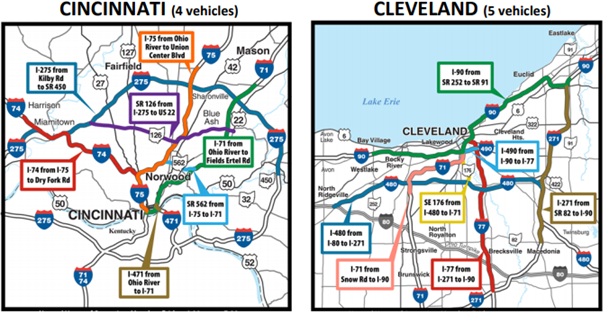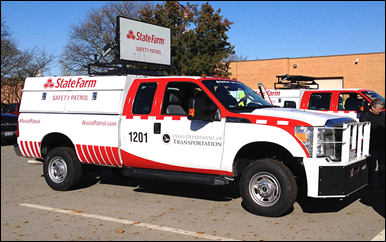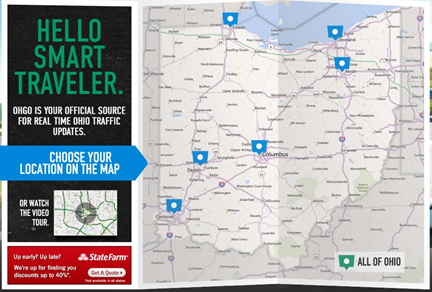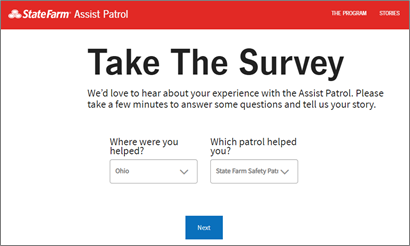The Ohio Department of Transportation (ODOT) found unconventional ways to raise money to offset transportation budget shortfalls, one of which was, in 2014, to enter into a naming rights agreement with State Farm Insurance. Under this agreement State Farm advertises on ODOT vans that patrol highways to assist motorists. This program will raise as much as $8.65 million over 10 years, covering most of the cost of the Freeway Safety Patrol operations.
The ODOT Freeway Safety Patrol assists stranded motorists and helps clear crashes and stranded vehicles from highways to reduce accident- and breakdown-related congestion and hazards. Operated by an ODOT contractor, Autobase Inc., the Freeway Safety Patrol service provides traffic control, medical assistance at crash sites, and assistance to stranded motorists by changing flat tires, providing small amounts of fuel, and fixing minor mechanical problems. The program operates Monday to Friday, 6 a.m. to 7 p.m., on Interstates and State highways in six of Ohio’s major urban areas: Akron–Canton, Cincinnati, Cleveland, Columbus, Dayton, and Toledo. Vehicles are allocated according to the size of the city, with five vehicles in Cleveland and Columbus, four in Cincinnati, and two in Toledo and Dayton. Figure 1 shows the patrol areas for Cincinnati and Cleveland.
ODOT analysis has found that the Freeway Safety Patrol generates a significant return on investment on the basis of its safety and congestion benefits alone.1 Thus, the service is valuable to the State. The service vehicles also provide a marketing that has value to private companies. The Safety Patrol naming rights program allows ODOT to capture that value in the form of an unprogrammed, long-term revenue source.
Figure 1 . Map of State Farm Safety Patrol service area

Source: Travelers Marketing Press Release, 2014
After 13 years of operation, in 2014 the 24-vehicle Freeway Safety Patrol was rebranded the State Farm Safety Patrol in accordance with the naming rights agreement.2 The State Farm sponsorship, will generate $8.65 million in revenues over the 10-year contract period, and helps to offset the cost of the program and other state maintenance obligations.3 Safety patrol vehicles now operate with both ODOT and State Farm logos (see Figure 2) and drivers wear uniforms that identify them as ODOT contractors.4 The sponsorship also includes the placement of State Farm branding on signs on the 500 miles of road that make up the program service areas.
Besides the vehicles and road signs advertising the sponsorship, ODOT must collaborate with State Farm on social media (Twitter, Facebook, and Instagram) at least twice a year. State Farm also places an advertisement on the Ohio Traveler information website (see Figure 3).
Figure 2 . State Farm Safety Patrol vehicles

Source: Travelers Marketing Press Release, 2014.
Figure 3 . Ohio traveler information website featuring State Farm advertisement

Source: Ohio DOT traveler information website (ohgo.com). Accessed May 4, 2021.
State Farm also supports data collection and program feedback by distributing feedback cards to motorists and accepting feedback online through the State Farm Assist Patrol website (see Figure 4).5 The program has a high rate of positive feedback, and State Farm communicates with Ohio to identify and evaluate any negative feedback it receives.
Figure 4 . State Farm Assist Patrol website during feedback collection

Source: State Farm Assist Patrol Program (assistpatrol.com). Accessed May 2021.
The Freeway Safety Patrol was founded in 2001 as an ODOT program assisting stranded motorists free of charge to help keep Interstates and state highways safe. In 2011, as the State was facing a $1.6 billion funding gap,6 the State legislature passed Sections 5501.70 through 5501.83 of the Ohio Revised Code giving ODOT the authority to enter into public-private partnerships to finance and develop transportation projects.7 In 2016, 38 States had some form of legislation enabling transportation agencies to enter into public-private partnerships.8
After the passage of the legislation, ODOT established the Division of Innovative Delivery to develop sustainable funding sources for construction projects. One of the department’s first initiatives to generate revenue, in 2012, was to enter into a contract with Travelers Marketing to sell rest area sponsorships at 45 rest stops on Interstates. Travelers Marketing is a company specializing in developing partnerships with government agencies that support corporate marketing goals using public assets.
In 2014, the Division of Innovative Delivery and Ohio used a third-party marketing contractor to negotiate the State Farm sponsorship of the Freeway Safety Patrol with Travelers Marketing, which represented State Farm for this branding program. State Farm supported similar programs in 12 other states in 2014 and now supports 21 such programs. The experience of the State Farm and Travelers marketing team in other states was a key draw for ODOT, and the sponsorship was the first major contract signed after the 2011 legislation was passed. The initial contract for Safety Patrol’s naming rights included a third-party consultant to facilitate negotiations between Ohio and providers Travelers Marketing and State Farm. In the most recent renegotiation of the sponsorship contract, Ohio worked exclusively with Travelers Marketing and State Farm. At this point in the rebid, ODOT and the Department of Innovative Delivery had the experience and staff to engage directly, without a third-party consultant, to renew the contract with Travelers and State Farm.
ODOT contracts out operations of the Safety Patrol: The contractor purchases the trucks, maintains them, and provides the staff to operate the Safety Patrol. The current contractor is Autobase, Inc. The success of Safety Patrol operations and the revenue from selling naming rights made it possible to put additional equipment into service in 2019.
Because ODOT already provided the Safety Patrol service, adding naming rights was a low-cost, low-effort way to generate unrestricted revenue for ODOT. The revenue covers the cost of the service, provides safety benefits to motorists in the six service areas, and funds other ODOT programs. The naming rights also provide further justification for the Safety Patrol program during times of economic decline because the naming-rights revenue does not fluctuate from year to year with economic conditions.
The Ohio Turnpike, operated by the Turnpike Authority, which is separate from ODOT, established a similar program using a different firm and contract.9
The total value of the initial 10-year State Farm Safety Patrol sponsorship contract was $8.65 million (see Table 1). This amount was based on the projected number of market impressions that the program would generate—which is the number of times that an advertisement or branded product is shown to the public. For this program, this calculation was based on average traffic patterns on the 500 miles of road where the program operates.
The sponsorship revenue goes into the ODOT general budget pool and is not earmarked for any specific purpose. This gives ODOT the flexibility to use the revenue on a variety of programs and projects, to fill budget gaps, or to offset the $5 million annual cost of the Freeway Safety Patrol.
|
Years |
Annual Revenue |
Cumulative Revenue |
|---|---|---|
1–4 |
$850,000 |
$3,400,000 |
5–10 |
$875,000 |
$5,250,000 |
Total |
- |
$8,650,000 |
Note: Amounts in 2014 dollars.
With 24 vehicles, the ODOT contract revenue averages out to $36,000 per vehicle annually. Of the States with similar sponsorship agreements with State Farm, Ohio’s is one of the largest. North Carolina’s safety patrol has 70 vehicles, but the State Farm sponsorship fee averages out to only about $9,000 per vehicle annually.10 New Jersey has a fleet of 52 vehicles and a larger urban population and is sponsored at a per-vehicle rate comparable to the rate in Ohio.11
The Wisconsin DOT State Farm Safety patrol receives a $225,000 annual sponsorship fee, which is roughly a quarter of the value of the Ohio contract. But the total cost to operate the program in Wisconsin is about $1 million, so the sponsorship offsets about 17 percent of the cost, a similar ratio to that of other States. As in Ohio, the value of the sponsorship contract is determined by the number of estimated market impressions for the sponsor, which is based on the average traffic on the relevant roads and the size of the area in which a program operates. Thus, states with larger urban populations or more heavily traveled roads are better positioned to negotiate higher sponsorship fees.
On seeing the State Farm branding, most motorists assume that the State Farm Safety Patrol is a service for State Farm customers and usually express sentiments along the line of “I’m not a State Farm customer.” This results in a pleasant surprise when motorists in trouble learn that this is in fact a free program operated by ODOT and they do not have to be a State Farm customer to benefit. This subversion of expectations may positively influence perception of the program, which has favorable feedback rates above 95 percent. Of course, this creates a positive association for State Farm and helps the company create a positive reputation with travelers in the state. One criticism of this is that ODOT loses some of the public goodwill created by providing a successful service for motorists and ensuring safety in the service areas.
The State Farm sponsorship is meant to be a long-term partnership. The contract was recently renewed, but because of uncertainty created by the coronavirus pandemic at the time of renegotiation, the sponsorship contract is now on a year-by-year basis rather than a 10-year term.
Although the revenue from the sponsorship is not earmarked for the Safety Patrol operating budget, the revenue generated through this sponsorship helps to justify the State’s continued investment in operating a safety patrol. Using FHWA’s Tool for Operations Benefit Cost Analysis (TOPS-BC), ODOT estimates that the Freeway Safety Patrol program had a return on investment of approximately 11 to 1, based entirely on safety and congestion benefits, excluding sponsorship revenue.12 The program and the sponsorship are therefore likely to continue for the foreseeable future despite periods of economic decline or financial hardship.
The revenue from naming rights could provide justification to other state DOTs considering implementing safety patrols, because this type of public-private partnership will either subsidize or potentially generate program-sustaining revenue, depending on how the naming rights agreement is structured. Safety patrol programs can also create positive interactions with the public.
The initial naming rights contract enabled the Division of Innovative Delivery to establish in-house expertise to engage in naming-rights agreements without intermediaries and understand the value of the branding of commercial entities on Safety Patrol vehicles and other signage. This will enable ODOT to pursue future contracts or agreements when needed or when opportunities arise. The naming-rights revenue in support of the Safety Patrol provides economic value through the patrol’s operations of clearing crashes, helping stranded motorists, and reducing related congestion. These naming-rights agreements present a valuable opportunity for private companies to generate brand awareness and highlight motorist services. For the public agency, the naming agreement monetizes the value in the form of a flexible unprogrammed revenue source that has a low acquisition cost.
Ohio DOT Office of Traffic Management
John MacAdam, P.E. (Administrator)
John.MacAdam@dot.ohio.gov
Michael McNeill, P.E. (TMC and Operations Engineer)
Michael.McNeill@dot.ohio.gov
1 ODOT Analysis using the FHWA TOPS Benefit Cost Tool.
2 Ohio Department of Transportation, Freeway Safety Patrol. https://www.transportation.ohio.gov/wps/portal/gov/odot/programs/traffic-management/resources/freeway-safety-patrol
3 “ODOT will raise up to $8.65 million by letting State Farm put its name on freeway safety service vans.” cleveland.com, June 9, 2014. https://www.cleveland.com/metro/2014/06/odot_allows_state_farm_to_wrap.html
4 Travelers Marketing, Ohio DOT State Farm Safety Patrol Fact Sheet
5 https://www.assistpatrol.com/
6 Interview with ODOT Director Jerry Wray, Reason Foundation, 2012. https://reason.org/commentary/ohio-transportation-ppp/
7 ODOT Public-Private Initiatives Policies. https://www.transportation.ohio.gov/wps/portal/gov/odot/about-us/policies-and-procedures/policies/34-001-p
8 National Conference of State Legislatures, “Building-Up: How States Utilize Public-Private Partnerships for Social & Vertical Infrastructure,” February 16, 2017. https://www.ncsl.org/research/transportation/building-up-how-states-utilize-public-private-partnerships-for-public-multi-sector-vertical-infrastructure.aspx
9 Section 5537.30: Program for the placement of business logos for identification purposes on directional signs in the turnpike right-of-way. https://codes.ohio.gov/ohio-revised-code/section-5537.30
10 “State Farm name goes on NCDOT safety patrols in deal”. Citizen Times, May 13, 2015. https://www.citizen-times.com/story/news/local/2015/05/13/state-farm-name-goes-ncdot-safety-patrols-deal/27240017/
11 “State Farm to sponsor New Jersey safety patrols”. Fleet Owner, April 13, 2012. https://www.fleetowner.com/safety/article/21682469/state-farm-to-sponsor-new-jersey-safety-patrols
12 For more information on the TOPS Benefit Cost Tool: https://ops.fhwa.dot.gov/plan4ops/topsbctool/index.htm